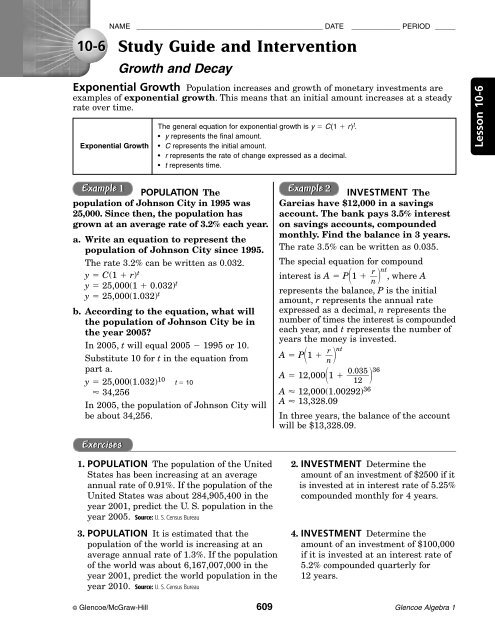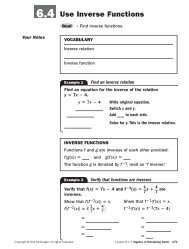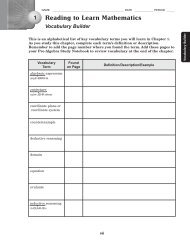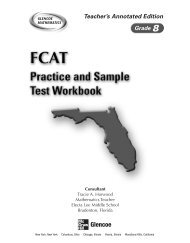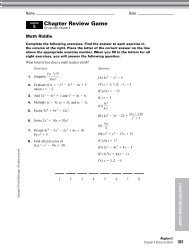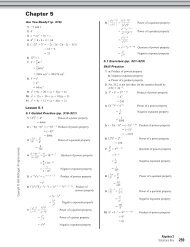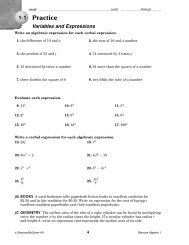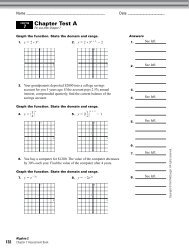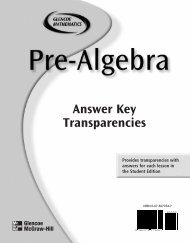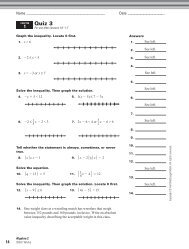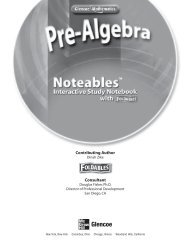Study Guide and Intervention (continued) - MathnMind
Study Guide and Intervention (continued) - MathnMind
Study Guide and Intervention (continued) - MathnMind
Create successful ePaper yourself
Turn your PDF publications into a flip-book with our unique Google optimized e-Paper software.
10-6<br />
NAME ______________________________________________ DATE ____________ PERIOD _____<br />
<strong>Study</strong> <strong>Guide</strong> <strong>and</strong> <strong>Intervention</strong><br />
Growth <strong>and</strong> Decay<br />
Exponential Growth Population increases <strong>and</strong> growth of monetary investments are<br />
examples of exponential growth. This means that an initial amount increases at a steady<br />
rate over time.<br />
The general equation for exponential growth is y C(1 r) t .<br />
• y represents the final amount.<br />
Exponential Growth • C represents the initial amount.<br />
• r represents the rate of change expressed as a decimal.<br />
• t represents time.<br />
Example 1 Example 2<br />
POPULATION The<br />
population of Johnson City in 1995 was<br />
25,000. Since then, the population has<br />
grown at an average rate of 3.2% each year.<br />
a. Write an equation to represent the<br />
population of Johnson City since 1995.<br />
The rate 3.2% can be written as 0.032.<br />
y C(1 r) t<br />
y 25,000(1 0.032) t<br />
y 25,000(1.032) t<br />
b. According to the equation, what will<br />
the population of Johnson City be in<br />
the year 2005?<br />
In 2005, t will equal 2005 1995 or 10.<br />
Substitute 10 for t in the equation from<br />
part a.<br />
y 25,000(1.032) 10<br />
t 10<br />
34,256<br />
In 2005, the population of Johnson City will<br />
be about 34,256.<br />
Exercises<br />
INVESTMENT The<br />
Garcias have $12,000 in a savings<br />
account. The bank pays 3.5% interest<br />
on savings accounts, compounded<br />
monthly. Find the balance in 3 years.<br />
The rate 3.5% can be written as 0.035.<br />
The special equation for compound<br />
interest is A P1 nt<br />
, where A<br />
represents the balance, P is the initial<br />
amount, r represents the annual rate<br />
expressed as a decimal, n represents the<br />
number of times the interest is compounded<br />
each year, <strong>and</strong> t represents the number of<br />
years the money is invested.<br />
A P1 nt<br />
A 12,0001 36<br />
A 12,000(1.00292) 36<br />
r<br />
<br />
n<br />
r<br />
<br />
n<br />
0.035<br />
<br />
12<br />
A 13,328.09<br />
In three years, the balance of the account<br />
will be $13,328.09.<br />
1. POPULATION The population of the United 2. INVESTMENT Determine the<br />
States has been increasing at an average amount of an investment of $2500 if it<br />
annual rate of 0.91%. If the population of the is invested at in interest rate of 5.25%<br />
United States was about 284,905,400 in the compounded monthly for 4 years.<br />
year 2001, predict the U. S. population in the<br />
year 2005. Source: U. S. Census Bureau<br />
3. POPULATION It is estimated that the 4. INVESTMENT Determine the<br />
population of the world is increasing at an amount of an investment of $100,000<br />
average annual rate of 1.3%. If the population if it is invested at an interest rate of<br />
of the world was about 6,167,007,000 in the 5.2% compounded quarterly for<br />
year 2001, predict the world population in the 12 years.<br />
year 2010. Source: U. S. Census Bureau<br />
© Glencoe/McGraw-Hill 609 Glencoe Algebra 1<br />
Lesson 10-6


